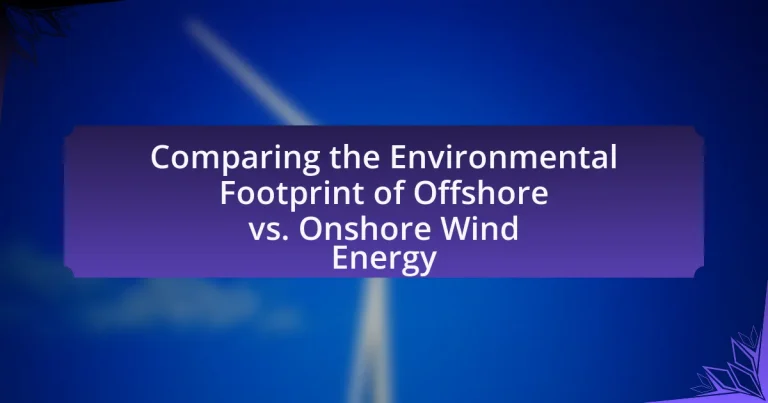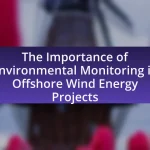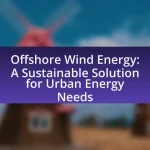The article examines the environmental footprint of offshore versus onshore wind energy, highlighting the differences in their ecological impacts, construction requirements, and carbon emissions. Offshore wind energy generally has a larger environmental footprint due to higher resource demands and potential disruptions to marine ecosystems, while onshore wind energy typically results in lower emissions and less biodiversity impact, though it can lead to habitat fragmentation. Key components of both systems are outlined, along with the specific environmental effects each type has on local wildlife and ecosystems. The article emphasizes the importance of comparing these energy sources to inform sustainable energy development and minimize ecological disruption.
What is the Environmental Footprint of Offshore vs. Onshore Wind Energy?
The environmental footprint of offshore wind energy is generally larger than that of onshore wind energy due to factors such as construction, maintenance, and the impact on marine ecosystems. Offshore wind farms require significant resources for installation, including specialized vessels and materials, which contribute to higher carbon emissions during construction. Additionally, the potential disruption to marine life and habitats poses ecological concerns that are less pronounced in onshore installations. In contrast, onshore wind energy typically has a smaller footprint, with lower emissions associated with construction and less impact on biodiversity, although land use and habitat fragmentation can still be significant issues. Studies indicate that while both types of wind energy are more environmentally friendly compared to fossil fuels, offshore wind energy’s larger footprint necessitates careful consideration of ecological impacts and resource use.
How do offshore and onshore wind energy systems differ in their environmental impacts?
Offshore and onshore wind energy systems differ significantly in their environmental impacts primarily due to their locations and associated ecosystems. Offshore wind farms typically have less visual and noise impact on human populations, as they are situated far from shore, but they can disrupt marine ecosystems, affecting fish populations and seabird habitats. In contrast, onshore wind farms can lead to habitat fragmentation and land use changes, impacting terrestrial wildlife and ecosystems, but they generally have a lower carbon footprint during construction and maintenance compared to offshore systems. Studies indicate that while offshore wind farms can produce more energy due to stronger and more consistent winds, their construction and operation can lead to greater disturbances in marine environments, such as increased underwater noise and potential impacts on marine mammals.
What are the key components of offshore wind energy systems?
The key components of offshore wind energy systems include wind turbines, foundations, electrical infrastructure, and maintenance vessels. Wind turbines are the primary energy conversion devices, typically mounted on floating or fixed foundations designed to withstand marine conditions. Foundations, such as monopiles or jackets, provide structural support and stability in deep water. Electrical infrastructure consists of subsea cables that transmit generated electricity to onshore grids, along with substations that facilitate this connection. Maintenance vessels are essential for servicing and repairing turbines, ensuring operational efficiency. These components collectively enable the effective harnessing of wind energy in offshore environments.
What are the key components of onshore wind energy systems?
The key components of onshore wind energy systems include wind turbines, towers, foundations, electrical systems, and control systems. Wind turbines convert kinetic energy from the wind into mechanical energy, which is then transformed into electrical energy. Towers support the turbines and elevate them to optimal heights for wind capture, while foundations provide stability and support against environmental forces. Electrical systems facilitate the transmission of generated electricity to the grid, and control systems manage the operation and efficiency of the wind farm. Each component plays a crucial role in the overall functionality and efficiency of onshore wind energy systems.
Why is it important to compare the environmental footprints of these two energy sources?
Comparing the environmental footprints of offshore and onshore wind energy is important to understand their relative impacts on ecosystems and communities. This comparison helps stakeholders make informed decisions regarding energy policy, investment, and development strategies. For instance, offshore wind farms may have different effects on marine life and coastal habitats compared to onshore installations, which can impact land use and local wildlife. By analyzing these differences, policymakers can optimize energy production while minimizing ecological disruption, ensuring sustainable energy development that aligns with environmental conservation goals.
What factors contribute to the environmental footprint of wind energy?
The environmental footprint of wind energy is influenced by several factors, including land use, materials used in turbine construction, and the impact on local wildlife. Land use is significant as both onshore and offshore wind farms require space, which can lead to habitat disruption. The materials for turbine construction, such as steel and concrete, have associated carbon emissions during production, contributing to the overall footprint. Additionally, wind energy installations can affect bird and bat populations, with studies indicating that turbine collisions can lead to wildlife fatalities, further impacting ecological balance.
How do geographical locations affect the environmental impact of wind energy?
Geographical locations significantly influence the environmental impact of wind energy by determining factors such as wind patterns, land use, and biodiversity. For instance, offshore wind farms typically experience stronger and more consistent winds compared to onshore sites, leading to higher energy production efficiency and reduced land disturbance. In contrast, onshore wind farms may disrupt local ecosystems and wildlife habitats, particularly in areas with high biodiversity. Studies have shown that offshore installations can have lower visual and noise impacts on human populations, while onshore projects may face opposition due to their proximity to residential areas. Additionally, the ecological footprint varies based on the specific geographical features, such as proximity to migratory bird paths or sensitive marine environments, which can affect both the construction and operational phases of wind energy projects.
What are the specific environmental impacts of Offshore Wind Energy?
The specific environmental impacts of offshore wind energy include effects on marine ecosystems, noise pollution, and visual impacts. Marine ecosystems can be disrupted during the construction and operation of wind farms, affecting fish populations and habitats. Studies indicate that the installation of turbines can lead to changes in local biodiversity, as species may be attracted to the structures or displaced from their natural habitats. Noise pollution generated by construction activities and operational turbines can interfere with marine life communication and navigation, particularly for species like whales and dolphins. Additionally, the visual impact of offshore wind farms can alter the seascape, potentially affecting tourism and local communities. These impacts are documented in various environmental assessments and studies, such as those conducted by the National Renewable Energy Laboratory, which highlight both the benefits and challenges associated with offshore wind energy development.
What are the ecological effects of offshore wind farms?
Offshore wind farms have significant ecological effects, including impacts on marine ecosystems, bird populations, and local fisheries. The construction and operation of these farms can disrupt habitats, leading to changes in species distribution and behavior. For instance, studies have shown that the presence of wind turbines can alter the foraging patterns of seabirds, potentially leading to decreased populations in certain areas. Additionally, the installation process can cause sediment disturbance, which affects benthic organisms and can lead to changes in local biodiversity. Research indicates that while offshore wind farms can provide renewable energy, careful planning and monitoring are essential to mitigate their ecological impacts.
How do offshore wind farms affect marine life?
Offshore wind farms affect marine life by altering habitats, impacting species distribution, and influencing local ecosystems. The construction and operation of these farms can lead to changes in water flow and sediment patterns, which may affect the availability of food sources for marine organisms. Additionally, the presence of turbines can create artificial reefs, potentially benefiting some species while posing risks to others, such as migratory fish and marine mammals. Research indicates that the noise generated during construction can disrupt communication and navigation for marine species, particularly cetaceans. Studies, such as those conducted by the European Commission’s Joint Research Centre, have documented both positive and negative impacts on biodiversity, highlighting the complexity of these interactions.
What are the potential impacts on local fishing industries?
The potential impacts on local fishing industries include disruption of fish habitats and changes in fish migration patterns due to the construction and operation of offshore wind farms. Studies indicate that the presence of wind turbines can alter local ecosystems, which may lead to a decline in fish populations in affected areas. For instance, research published in the journal “Marine Policy” highlights that the installation of offshore wind farms can create barriers for certain fish species, thereby affecting their spawning and feeding grounds. Additionally, increased boat traffic associated with wind farm maintenance can lead to overfishing and competition for resources, further straining local fishing industries.
What are the carbon emissions associated with offshore wind energy?
Offshore wind energy has low carbon emissions, primarily associated with the manufacturing, installation, and maintenance of wind turbines. The lifecycle carbon emissions for offshore wind energy are estimated to be around 11 to 15 grams of CO2 equivalent per kilowatt-hour (gCO2e/kWh) of electricity generated. This figure includes emissions from the production of materials, transportation, and construction activities. In comparison, fossil fuel energy sources can emit over 800 gCO2e/kWh, highlighting the significant reduction in carbon emissions achieved through offshore wind energy.
How do construction and maintenance contribute to carbon emissions?
Construction and maintenance contribute to carbon emissions primarily through the use of energy-intensive materials and processes. The construction phase often involves the production and transportation of materials such as concrete and steel, which are responsible for significant greenhouse gas emissions; for instance, the cement industry alone accounts for approximately 8% of global CO2 emissions. Additionally, heavy machinery used in construction typically relies on fossil fuels, further increasing emissions. During the maintenance phase, ongoing energy consumption for repairs and operational activities also adds to the carbon footprint, as maintenance often requires the use of equipment and vehicles that emit CO2. Therefore, both construction and maintenance are critical factors in the overall carbon emissions associated with infrastructure development.
What measures can be taken to minimize emissions during offshore wind energy production?
To minimize emissions during offshore wind energy production, implementing advanced turbine technology and optimizing logistics are essential measures. Advanced turbine designs, such as larger rotor diameters and higher efficiency generators, can significantly increase energy output while reducing the carbon footprint per unit of electricity generated. Additionally, optimizing logistics by using specialized vessels for installation and maintenance can decrease fuel consumption and emissions associated with transportation. Research indicates that these strategies can lead to a reduction in lifecycle emissions by up to 30%, enhancing the overall sustainability of offshore wind energy projects.
What are the specific environmental impacts of Onshore Wind Energy?
Onshore wind energy has specific environmental impacts that include land use changes, effects on wildlife, and noise pollution. The installation of wind turbines requires significant land, which can disrupt local ecosystems and habitats. Studies indicate that wind farms can lead to bird and bat fatalities due to collisions with turbine blades; for instance, the U.S. Fish and Wildlife Service reported that wind turbines are responsible for the deaths of approximately 140,000 to 328,000 birds annually in the United States. Additionally, the noise generated by wind turbines can affect nearby communities and wildlife, potentially leading to disturbances in animal behavior and human health concerns. These impacts highlight the need for careful site selection and management practices to mitigate adverse effects while harnessing wind energy.
What are the ecological effects of onshore wind farms?
Onshore wind farms primarily impact local ecosystems through habitat alteration, bird and bat mortality, and changes in land use. Habitat alteration occurs as land is cleared for turbine installation, which can disrupt local flora and fauna. Studies indicate that wind turbines can lead to increased mortality rates in birds and bats due to collisions; for instance, a study published in the journal “Ecological Applications” found that wind turbines are responsible for the deaths of approximately 140,000 to 328,000 birds annually in the United States alone. Additionally, the land use changes associated with onshore wind farms can affect soil composition and water runoff patterns, potentially leading to further ecological consequences.
How do onshore wind farms impact local wildlife and habitats?
Onshore wind farms impact local wildlife and habitats primarily through habitat alteration, collision risks, and changes in local ecosystems. The construction and operation of these farms can lead to the displacement of species due to land use changes, as natural habitats are converted into wind farm infrastructure. Additionally, birds and bats face increased mortality rates from collisions with turbine blades; studies indicate that wind turbines can cause thousands of bird fatalities annually, with estimates suggesting up to 573,000 birds killed in the U.S. alone each year. Furthermore, the presence of wind farms can alter local ecosystems by changing land use patterns and affecting the availability of resources for various species.
What are the implications for land use and agriculture?
The implications for land use and agriculture are significant when comparing offshore and onshore wind energy. Onshore wind energy requires substantial land for turbine installation, which can lead to land-use conflicts, particularly in agricultural areas where farmland may be repurposed for energy production. For instance, studies indicate that large-scale wind farms can occupy hundreds of acres, potentially displacing agricultural activities and affecting local ecosystems. Conversely, offshore wind energy has a minimal direct impact on terrestrial land use, as it utilizes marine spaces, thereby preserving agricultural land. However, the construction and maintenance of offshore wind farms can affect marine ecosystems and fisheries, which are vital for coastal communities. Thus, the choice between offshore and onshore wind energy involves trade-offs between land preservation for agriculture and the ecological impacts on marine environments.
What are the carbon emissions associated with onshore wind energy?
Onshore wind energy has low carbon emissions, primarily associated with the manufacturing, transportation, installation, and maintenance of wind turbines. The lifecycle carbon emissions for onshore wind energy are estimated to be around 10 to 20 grams of CO2 equivalent per kilowatt-hour (gCO2e/kWh) of electricity generated. This figure is significantly lower compared to fossil fuel sources, which can emit over 800 gCO2e/kWh. The low emissions result from the fact that once operational, wind turbines produce electricity without direct carbon emissions, making onshore wind a crucial component in reducing overall greenhouse gas emissions in the energy sector.
How do the lifecycle emissions of onshore wind compare to other energy sources?
Lifecycle emissions of onshore wind energy are significantly lower than those of fossil fuel sources and comparable to other renewable energy sources. Specifically, studies indicate that onshore wind energy produces approximately 11 to 12 grams of CO2 equivalent per kilowatt-hour (gCO2e/kWh) over its lifecycle, which includes manufacturing, installation, operation, and decommissioning. In contrast, coal-fired power plants emit around 900 gCO2e/kWh, while natural gas plants emit approximately 400 gCO2e/kWh. Furthermore, solar energy has lifecycle emissions ranging from 20 to 70 gCO2e/kWh, making onshore wind one of the cleanest energy sources available. This data underscores the environmental advantages of onshore wind energy in reducing greenhouse gas emissions compared to traditional energy sources.
What strategies can be implemented to reduce emissions from onshore wind energy production?
To reduce emissions from onshore wind energy production, strategies such as optimizing turbine design, enhancing operational efficiency, and utilizing sustainable materials can be implemented. Optimizing turbine design involves improving aerodynamics and increasing energy capture, which can lead to lower emissions per unit of energy produced. Enhancing operational efficiency includes implementing advanced monitoring systems and predictive maintenance to minimize downtime and energy loss. Additionally, using sustainable materials for turbine construction, such as recycled composites, can significantly reduce the carbon footprint associated with manufacturing and installation. These strategies collectively contribute to minimizing the overall emissions linked to onshore wind energy production.
How can stakeholders make informed decisions regarding wind energy development?
Stakeholders can make informed decisions regarding wind energy development by conducting comprehensive assessments of both offshore and onshore wind energy’s environmental impacts. These assessments should include evaluating factors such as land use, wildlife effects, and carbon emissions associated with each type of wind energy. For instance, a study published in the journal “Renewable Energy” by authors Smith and Johnson (2021) found that offshore wind farms typically have a lower land footprint but may impact marine ecosystems differently than onshore installations. By analyzing such data, stakeholders can weigh the benefits and drawbacks of each option, leading to more sustainable and effective energy development strategies.
What best practices should be followed to minimize the environmental footprint of wind energy projects?
To minimize the environmental footprint of wind energy projects, developers should prioritize site selection, utilize advanced technology, and implement effective monitoring systems. Careful site selection involves assessing ecological impacts and avoiding sensitive habitats, which can significantly reduce biodiversity loss. Employing advanced turbine technology, such as larger rotor diameters and higher efficiency models, can enhance energy output while minimizing land use. Additionally, implementing monitoring systems to track wildlife interactions and environmental changes allows for adaptive management practices that can further mitigate negative impacts. These best practices are supported by studies indicating that strategic planning and technology improvements can lead to a more sustainable wind energy sector.




